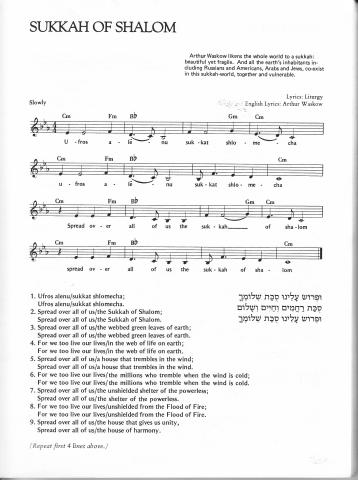Submitted by Rabbi Arthur Waskow on

Blessings to us all as the Jewish harvest festival of Sukkot begins tonight -- a festival rich in meaning for all Humanity and all of Earth.
(To expand on the song graphic,click on it.)
There are two major symbols of Sukkot – both evocative of a close relationship between human beings and the Earth. (In Hebrew, “earthy humus” is adamah, which gives birth to adam – human earthlings. See Gen 2: 7.)
One of these symbols is that we build sukkot -- fragile, temporary “homes” with leafy, leaky roofs.
Traditionally, families would eat and sleep in these fragile huts for seven days.
Our evening prayers say to the Holy One Who is the Breath of Life -- “Ufros aleinu sukkat sh'lomecha; Spread Over Us the Sukkah of Your Peace.”
Why does the prayer seek a "sukkah of shalom," rather than a strong fortress, a tower, a palace, a temple, even a more stable, solid house of shalom?
Precisely because the sukkah is a vulnerable hut -- vulnerable in space and time. See attached a poster from 40 years ago, redolent of that teaching in one of the earliest actions sponsored by The Shalom Center.
In political-military fact and in spiritual truth, we all live lives that are vulnerable, though we often pretend that steel and concrete and toughness will protect us. (See 9/11/01 for evidence to the contrary.) If as the Prophet Dylan wrote, "A Hard Rain Gonna Fall," no tower will shield us.
Only if we can all recognize that we all live in a vulnerable sukkah can we be at peace with our selves and each other. Our graphic of a Sukkot song that celebrates this vulnerability can be expanded by clicking on it.
(Please note -- The words of this song are mine, but the melody is not, despite the note above. It follows, with different words, the melody of a sukkah song by Rabbi Aryeh Hirschfeld, whose memory is a blessing.)
The other symbol is that we wave a bundle of three sets of branches and one fruit in the seven directions of the universe -- left, right, up, down, forward, behind – and Inward. (Seeing it as seven directions, not just six, is the teaching of Rabbi Shefa Gold.) This wave-offering on Sukkot is the last survival of the many wave-offerings at the ancient Temple in Jerusalem.
The branches of myrtle, willow, and palm are held in one hand; a small lemony fruit – the etrog or citron in the other. Then they are ceremoniously united by bringing the two hands together.
There is clearly some erotic/sexual/ earthy/ ”pagan” element in this unification of what is long and wavy with what is small, juicy, and fragrant. (As Reb Zalman Schachter-Shalomi once said, “If we do it, it’s not ‘pagan.’”)
The etrog looks like the Hebrew letter “Yod,” which is a small dot-like letter. (Its name gave rise to the words “iota” and “jot” to denote something tiny.) The long stiff palm branch looks like the Hebrew letter “Vav.” The myrtle and willow branches, soft and curvy, look like the Hebrew letter “Hei.” So together these four make the “word” Yod-Hei-Vav-Hei, the four-letter name of God – YHWH.
Waving the four in unison, the ancient Rabbis taught, made visible and tactile and earthy the name of God.
But there’s an oddity. The way the four species are held in the hands of the waver, with the etrog for "Yod" in the left hand, if the letters are read from right to left as they should be in Hebrew, they would spell the Name backward – HWHY. That word, pronounced “Hawayah,” means “Being, Existence.” One fitting metaphor for God, but not the same as the traditional Name.
The only way in which we can see the name in its ancient form is if someone else is watching as the waver waves. Seen from “opposite,” Encountering, the Name does read from right to left as “YHWH.” Only in I-Thou relationship does the Name appear.
For me, one of the richest teachings of this wave-offering came from my son, David Waskow, when he was ten years old and waved the branches for the first time. I asked him how it felt, and he answered: “I felt like I was a tree. I could hear the wind in my own branches, I could smell my own fruit!”
When the Torah forbids the wanton cutting-down of the “enemy’s” trees in time of war, it asks the question, “Is the tree human?” (Deut. 20: 19–20.)
The answer is Yes. A teaching for our generation.



















